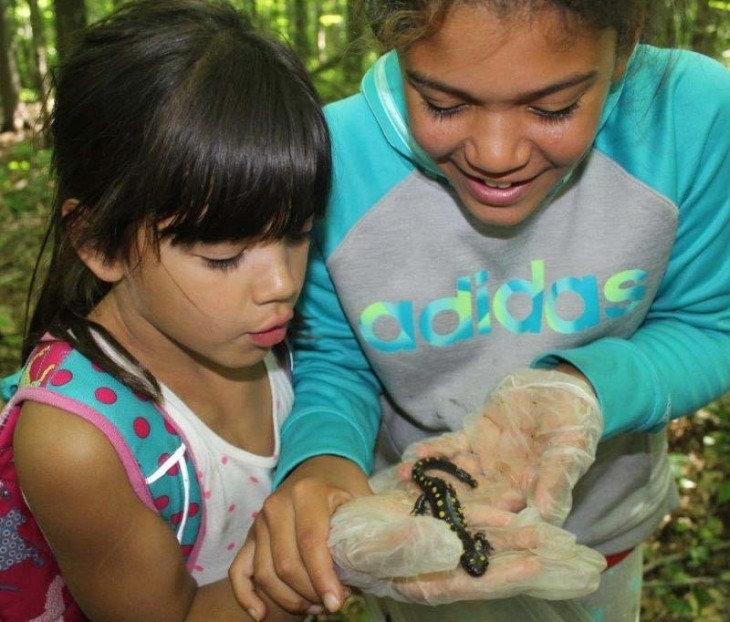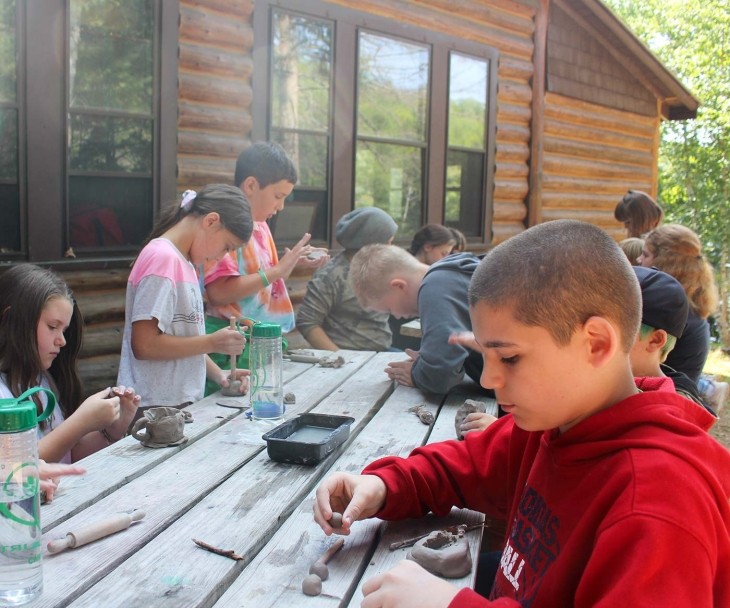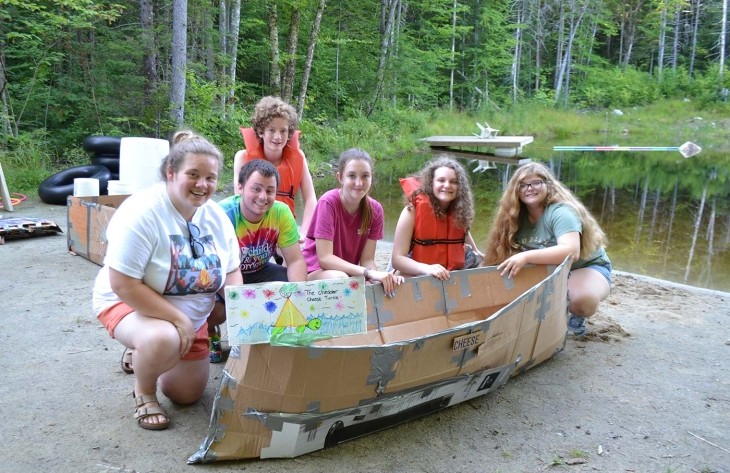
It’s a hot, humid August morning in St. Johnsbury, Vermont, the kind that usually yields thunder and lightning by day’s end. But at nearby Buck Lake – just 700 feet higher in the Vermont woods – someone set the thermostat to “paradise.” The air is dry, the temperature hovers in the mid-70s, and a light breeze ripples the lake’s sapphire surface.
To the 60 or so young teenage boys bunking at Buck Lake Camp, it sure feels like heaven. They are nearing the end of their week at one of two Green Mountain Conservation Camps (GMCC). (The other, Edward F. Kehoe Camp, is across the state in Castleton.) They’ve practiced with hunting crossbows at the archery range. They’ve learned to canoe safely, fire .22 rifles and 20-gauge shotguns, and will leave with hunter education certifications stuffed in their pockets and orange hats on their heads. In between those lessons, they’ve taken deep dives into conservation ethics, wildlife management, and habitat protection with Vermont game wardens and wildlife biologists.
Today, the boys are clustered around Butch Spear of the Vermont Bearhound Association and his mobile kennel, built on the frame of a muscular pickup. The lucky ones are clutching leads for some of Spear’s hounds as they investigate the grounds outside the camp’s science education center. Butch finds himself in a thick knot of boys, who are all eager to share their own experiences and dog knowledge.
“We had two pups from the same litter,” a reed-thin, red-headed boy tells Spear. “One grew up loving to hunt, but the other couldn’t care less. He just shows no interest when we go out.”
“That’s so,” Spear says. “It’s individual. It doesn’t matter the breed. Some dogs hunt and some just won’t.”
More boys dive into the conversation, but they don’t step on each other’s lines. Each gets a turn, and the others listen carefully before they jump in. Some have never hunted – in fact they’ve never been in the woods before this camp. Others claim a rural background and are the latest in a long line of hunters in the family. But when Spear clears his throat and starts to speak, the chatter stops. The respect turns up another notch – it’s practically awe as he describes a way of life, his own way of connecting to the natural world, that is as much a part of him as his flesh and bones.
According to Alison Thomas, education programs coordinator for the Vermont Fish & Wildlife Department, that awe is an everyday experience at Buck Lake.
“We want kids to get it straight from the source,” she says of the daily curriculum of expert presenters – including many who once attended or worked at the camp. “Their passion comes out. There’s a lot of emotion to go along with the facts.”
For more than 150 years, New England summer camps have introduced generations of children to the Northeast’s forests. According to the New England affiliate of the American Camp Association, the first summer camp was established in Connecticut in 1861. After a slow start, overnight camps grew in popularity during Theodore Roosevelt’s presidency – in part due to his own boosterism; he encouraged city children to “rough it” in the outdoors – and by 1918 there were more than 1,000 camps nationwide.
Due to high camp fees, perception, and a complicated history of exclusion, however, summer camps – and all the opportunities of attending – are often out of reach for many families. The Green Mountain Conservation Camps and others – including Camp Susan Curtis in Maine and Copper Cannon Camp in New Hampshire – endeavor to serve children from various backgrounds by reducing or eliminating fees and by demonstrating that the outdoors are for everyone.
A Commitment to Diversity
Overnight summer camps can cost upward of $325 a day. That sticker price has stoked the perception – perpetuated in movies such as The Parent Trap – that the camp experience is exclusive, the province of wealthy families.
The GMCC camps at Buck Lake (opened in 1971) and Kehoe (started in 1966) charge just $250 per camper for a week – and nearly half the girls and boys who attend receive full state scholarships or private sponsorships based on economic need. The Vermont Bearhound Association, for example, contributes $10,000 annually to enable children from diverse backgrounds – economically, geographically, racially, and culturally – to go to camp.
“This camp was created because its founders wanted to give every kid – regardless of socioeconomic status – an opportunity to be healthy, happy, well fed, and to learn important skills that connect them to nature,” says Thomas, who supervises operations at both GMCC camps. “Which is, of course, a human right. It shouldn’t be about how much money you make if you get to go play outside safely and in a healthy way.”
Camp Susan Curtis in Stoneham, Maine, which provides an overnight camp experience – tuition-free – to children who might otherwise never have such an opportunity, shares that same commitment to diversity. Its mission is “to provide a transformative camp experience that nurtures self-confidence and a sense of belonging in Maine children facing economic hardship.”
Set on 100 acres of conservation land abutting Trout Lake, Camp Susan Curtis has been called “the most beautiful summer camp in New England” by visitors from the American Camp Association. The old bunkhouses sit on an arc above the lake and the camp’s rope course, while a cat’s cradle of wooded trails lead to the arts and crafts building, the science building, and the cafeteria.
“You might think that everyone who grows up in Maine has been exposed to the outdoors,” says Camp Director Terri Mulks as a group of campers fly by single file on mountain bikes, hooting and hollering hellos. “You might think every kid has explored the outdoors, goes swimming in the summer and hunting in the fall. But you’d be wrong. When families just don’t have the resources, it doesn’t matter if the kids grow up in the city or the country. Many of our campers have never been on a bike before they arrive here.”
Peter Christnacht, director of Copper Cannon Camp – a tuition-free summer camp for New Hampshire’s underserved youth – tells a similar story. Although the camp provides a STEM curriculum during the course of a session, it also introduces children to a wide range of traditional outdoor activities, including swimming, canoeing, hiking, food gardening, and a full menu of games and sports.
“After I give an archery demonstration, I have kids who have asked me if I invented the bow and arrow,” Christnacht says. “When I show them how to start a fire with flint and steel, they think it’s magic. They just have no idea…. I have to explain that these tools have been used for eons.”
Thomas says it’s not just the price of camp that can limit diversity. There’s also a feeling among minority and underserved communities that residential camps aren’t for their children because of the kinds of traditional activities – from hunting and fishing to canoeing and mountain biking – that are typically offered. And there are also issues of trust – and fears about acceptance.
“I’m constantly meeting with members of different communities that are historically underrepresented at camp in hopes of finding ways to really engage with them authentically and to provide an experience to them where they feel welcome and safe and just really inspired by being part of the community at GMCC and being part of Vermont’s landscape,” Thomas explains. “I know that sounds fluffy, but it’s real. You want to invite everyone to participate, because the more diversity, the more resilient the program, the more interesting, the more fun it is.”
Learning to be One’s Own Self
Copper Cannon, located in Franconia, New Hampshire, under the majestic peak of Mount Lafayette, has served more than 22,000 children since its founding in 1963 by Hamilton “Ham” Ford. A new man-made pond serves as the center of its water activities, while a broad meadow is home to the camp’s many pickup soccer games and other ball sports. At different times of the day, campers might be working on arts and crafts in one of the camp’s common buildings, gathered at the ping-pong table, engaged in afternoon team-building activities beneath a towering evergreen grove, or simply bonding around the nightly campfire.
Christnacht says many first-time campers previously associated summers with lonely, latch-key days, food insecurity, and a range of dangers both within and beyond their homes. Only a third are being raised by their birth parents, he notes, and many are living in group homes.
It’s an existence Hamilton Ford himself knew all too well. Born in 1923, he was sent to live with relatives because his family was too poor to feed him. But at the age of 10 he attended a “family camp,” and his life changed forever. According to Copper Cannon Camp’s official history, Ham recalled that while at camp:
He saw his mother truly smile for the first time. It was also the first time he knew for sure he would get three proper meals a day, every day. Finally, the camp experience was one of the most fun, educational and impactful times of his young life. Afterwards, he decided that every kid deserved the same experience.
A year after he founded the camp at his Franconia ski lodge, the New Hampshire Elks adopted the program as its major statewide project and agreed to pay for 50 percent of the costs. While that funding has diminished over the years as a percentage of expenses, the Elks remain a major source of operating funds and, just as important, provide transportation for the campers, arranging buses for groups of campers from Manchester, Nashua, and Rochester, for example.
Support from the surrounding community has been essential. Garnet Hill, Franconia’s largest employer, shuts down for a day each summer so its employees can spend that day working to help get the camp ready for the new season. Snapper Rock has donated $25,000 in swimwear for campers. Another vendor provides items for the clothes closet, as many children arrive at camp without suitable attire. The New Hampshire National Guard donates school supplies, both for use at camp and for campers to bring home.
Copper Cannon’s transformational goal is to engage with children as young as 9 – and to keep them engaged until high school graduation. Christnacht says that if he can keep kids returning to camp long enough to join the ranks of counselors-in-training, “100 percent of them will go on to college or join the military.”
Gabriel Camuso is a shining example of the impact a camp experience can have on a young boy. In 2011, a school counselor recommended him for a session at Copper Cannon. He jumped at the opportunity and, at age 9, made his first trip to the camp, aboard an Elks bus.
“Growing up, I didn’t have much quiet at home,” Camuso explains. “I fell in love with the atmosphere here and all the opportunities I encountered. It was the first time I could really be myself. At Copper Cannon I learned how to be myself.”
He stayed connected through the camp’s teen leadership retreats and became a counselor-in-training in 2018. Today, he works at Copper Cannon summers between terms at Southern New Hampshire University, where he is majoring in IT and plays lacrosse. His career aspiration is to become a chief information security officer.
“That leadership – that desire to be a leader – all stems from my experiences here,” he says.
A Transformational Experience
Camuso’s experience – learning how to be himself – is a frequent refrain among campers, counselors, and staff at summer camps that are trying to reach underserved and minority communities. The heaviest loads these campers bring with them are not the packs on their backs but the weight of preconceived expectations about who they are – often based on racial, ethnic, gender, and economic stereotypes.
“Camp is a magical place where all the social hierarchies break down,” says Thomas. “Here there’s no baggage. You get to be your own true self. The only kids who struggle here are those who can’t show who they are without the things they wear or the things they own.”
GMCC Buck Lake Camp Coordinator Hannah Phelps remembers that transformative moment in her own life. The dread she felt in the days preceding her first camp session disappeared almost immediately when she realized that every other camper was much like her – uncertain but curious, anxious to fit in but suddenly free of the burdens of stereotypes.
“It was the first time in my life I was shamelessly myself,” Phelps says. “Camp takes kids out of these pre-structured, deterministic hierarchies…and mixes up the social structure. The important question became ‘Who do I want to be?’ not ‘Who am I supposed to be?’”
For some, camp inspires not only a lifelong connection to the outdoors, but a career path as well.
“Camp absolutely helped me realize that I wanted to pursue a career in environmental work,” says Molly Estabrook, 29, who currently teaches fourth grade at an outdoors school in Colorado. She first attended Buck Lake at the age of 12 and spent the next nine years as a camper, junior counselor, and natural resources instructor, ending her tenure as the camp director at Kehoe. So it wasn’t surprising that she found her way into environmental studies and wildlife biology in college, and eventually earned a master’s degree in special education.
“I learned so much through leading and working with so many different staff members and campers, who came from all walks of life,” Estabrook says.
Dakota Warren, who spent 10 days at Camp Susan Curtis soon after her ninth birthday, also experienced a personal transformation at camp. Coming from an impoverished and unimaginably difficult home environment, she was excited to get away but timid on arrival.
“All my life I had lacked self-confidence,” says Warren, who is now 26. “I was always the quietest person in the room.”
Within days, however, she found her voice, which she attributes to the camp’s ethos. “It was the freedom from expectations about who you were, or what you were supposed to be,” she recalls. “There was no pressure to play a role. I could just be a typical kid at camp.”
Returning the next summer, Warren was paired with a counselor named Shawneen who changed the young girl’s life.
“She was the first person I felt I could talk to about what was going on at home,” Warren says. “I had counselors, social workers, advocates…but I couldn’t talk to them. I trusted Shawneen because I sensed that she had been through it herself.”
That experience gave Warren the courage to leave the only home she had ever known, and she was soon adopted by a foster family – an event she calls the most important of her life, and one she will forever associate with Camp Susan Curtis.
Later, as a counselor-in-training, Warren participated in the Camp Susan Curtis “Camp to Campus” program, which sends older teens on day trips to local colleges to meet with students, faculty members, and admissions officers. “I had never even heard of the University of Southern Maine before that trip,” she recalls. “But it became my top choice.”
Warren has worked at the camp ever since, including stints as waterfront director and director of the camp’s bridge programming for teens who aren’t yet old enough for the leadership development. This past December, Warren earned her master’s degree in occupational therapy after completing four years of undergraduate work at USM and will be piloting a new social services role at Camp Susan Curtis. One of her initial goals is to find a way to incorporate all that she’s learned to help first-time campers understand that anything is possible.
“I don’t want them to see me as a role model or a special case,” she says. “I just played the hand I was dealt. But the important thing is that these kinds of stories can open kids’ eyes to what’s possible. They can break the cycle. They can achieve things they were told they could never do. And they can know that camp will always be here for you.”








